Heart of Houston
By Bob Machann
Reprinted from "Crown Jewels of the Wire", April 2005, page 11
(For Missy H., Shelley J. and Emily S.)
The Union Pacific Railroad's main trackage in Houston, Texas skirts the
northern edge of downtown Houston and passes through Houston's historic Heights
neighborhood. There are two tracks that come into downtown Houston from the
northeast. One feeds into a train yard, just east of Interstate 45.
The other, a little south, runs beside the Harris County jail, over the
Buffalo Bayou, and underneath the University of Houston's downtown campus. West
of UHD, the track passes Houston's main U.S. Post Office and serves the Houston
Amtrak office.
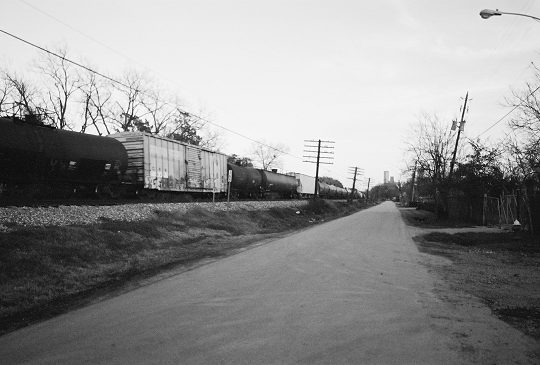
The two tracks meet at Chaney Junction. Near the tracks are a series of
warehouses, including ones for the Salvation Army and Bowne Printing, a rice
elevator, a junkyard, a bakery, an alternative school, a recycling yard, and a
barn that sells antiques.
Just north of Interstate 10, at Eureka junction, the tracks split. One turns
southward through Memorial Park, while the other bends northward. The latter
split was once the Southern Pacific Railroad's Dallas & Austin Division.
In a New Town
I had moved to Houston in August 1994 and immediately began law
courses.
Unfortunately, this left little time for looking at insulators, so my
weekends were at a premium. On a Saturday in September, I was riding in my
Pontiac Sunbird. I wasn't quite familiar with Houston's streets just yet, and I
was struggling along west Interstate 10 (or the Katy Freeway, as Houstonians
call it) to find a way back to my downtown apartment. I found the Washington
Avenue exit and took it. As I did, I heard a very familiar sound -- the b-flat
klaxon horn of a Southern Pacific locomotive. To my left, over the concrete
trestle spanning the Katy Freeway basin, an SP freight was coming fast into
downtown.
I crossed the northbound lanes of Washington and cut through two parking lots
to get to a run-down residential area by the tracks. Rounding a bend in the
road, I now found myself on Allen Street, parallel to the tracks. I drove up
Allen Street and railfanned the passing train at the same time. Since there was
no one behind me, I stopped at T.C. Jester Boulevard and watched the train pass. There was traffic on the other side of the crossing,
so I high-tailed back to Washington Avenue before the cantilever crossing sticks
could rise for the oncoming traffic.
Amazingly, in the last days of summer 1994, poles were still standing along
these tracks. The wires had already been cut and removed, but a Warner
television cable strung along the tall poles was in very good repair. A few
strands of the old copper wire hung from some of the insulators in places. The
insulators here were mostly aqua and clear Hemingray #42s, with an occasional
Continental R-4 or black composition insulator. Although first glances were less
than stellar, I had just moved to Houston, and there was much more exploration
to come.
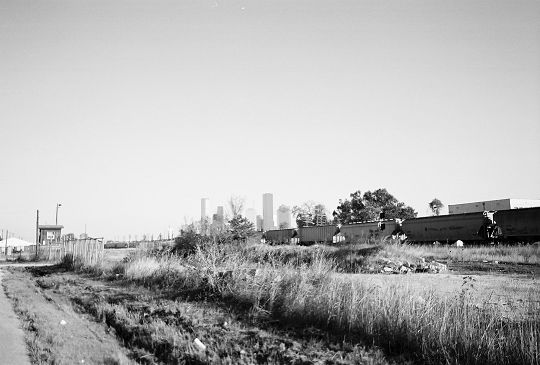
The First Walk
January 14, 1995 was a sunny Saturday in Houston. The
insulator bug was biting when I woke up that morning. I remembered the tracks
along Washington Avenue and opted to search there. In the winter of 1995, I was
living in the Houston House Apartments, a 30-story high-rise in downtown
Houston. The building's ninth floor was a social area of sorts. It was the site
of the building's swimming pool and deck, meeting rooms, basketball courts, and
a dance hall. At that time, the ninth floor had a small live-action theater on
its north end. As I came out the front door, Cindy, a friend from my oId college was coming in, along with two accomplices. We said
hello, and she told me that she was involved in a production being held in the
ninth floor theater. I explained that I was involved in hectic and frustrating
legal studies. Cindy wished me luck and encouraged me to keep going before we
said our goodbyes. Feeling surprised and a little happy, I continued my journey
toward Washington Avenue.
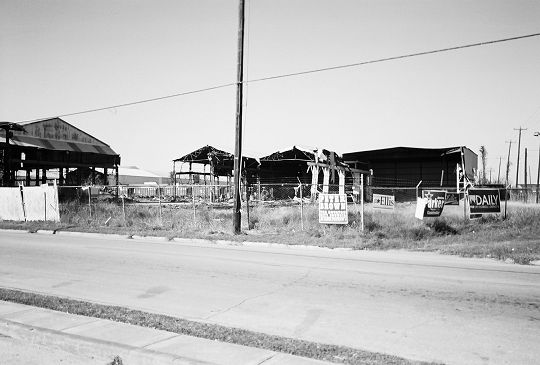
Walking in downtown Houston is an adventure. Over the past decade, downtown
Houston has undergone a transformation. With the construction of Minute Maid
field, Toyota Center, and the Metropolitan Transit Authority's light-rail line
on Main Street, much redevelopment of old hotels and restaurants has occurred.
Downtown is now a popular place.
In January 1995, however, these changes were just a gleam in some developer's
eye. In the shadows of brilliant, prosperous office buildings stood
weather-beaten hotels and long ranks of empty stores. In the middle of this, the
original old Foley's store and an ancient Woolworth's store were struggling to
hang on. On the east end of Franklin Street stood a worn industrial supply
storehouse that had seen better days. With panhandlers lumbering about and
street-corner preachers shouting fire-and-brimstone sermons at passersby, some
areas of downtown could be downright scary.
I did finally reach the tracks. I walked along Washington Avenue past the
downtown main post office, under Interstate 45, and past several buildings
before I reached Houston Avenue. Just north of the intersection was an underpass
that ran beneath the Southern Pacific tracks. A thick concrete pillar separated
the northbound and southbound lanes of Houston Avenue. On either side of the
lanes was a pedestrian passageway, or should I say what had once been a
pedestrian passageway. The dark, cavernous passageway by the northbound lane was
littered with garbage and stagnant water. The smell, like musty clothes that
have been in a hamper all week, was not necessarily pleasant, either. Not
surprisingly, most of the local pedestrians climbed over the railroad embankment
to get to the other side.
Once atop the embankment, I began hiking westward. I remember that moment
clearly. To my left was a very old brick building with vines growing up its
walls. Beyond it was an open lot beside a large feed store and a pipe supply
warehouse. To my right was a hardware store with a lumberyard. The aroma of
fresh cut wood wafted over to me and intermingled with the dust and the creosote
of the railroad tracks. As I passed the first few poles, I noticed that the
majority of the insulators were aqua and Hemingray Blue #42s, with a few clear
ones that were obviously replacements. The news was not all bad, however. A
search of the pole bases for grounders turned up a skirt shard for a clear CD
214 Hemingray. I now had something else to look forward to.
There was quite a bit of debris along the tracks. Among the objects I saw were the rusted hulk of some
family's Keystone home-movie projector, a
smashed business telephone, and a dusty wall calendar that looked as though
several trains had run over it. The tracks passed behind a Salvation Army
distribution center. I couldn't help noticing that the trackage behind the
center was a hangout for vagrants. The track bed was littered with the shattered
remains of as many as one hundred bottles of Magnum and Olde English malt
liquor. The trackside ditch was strewn with discarded clothes. Among these were
a teenage girl's bright green cowboy boots and a couple pairs of panties.
Beside the hodgepodge of clothes and broken bottles stood an insulator sight.
The pole there had five doubled crossarms loaded with dark aqua CD 214 Hemingray
#43s. I didn't have a CD 214 Hemingray #43 in dark aqua at the time, so this was
quite a find for me.
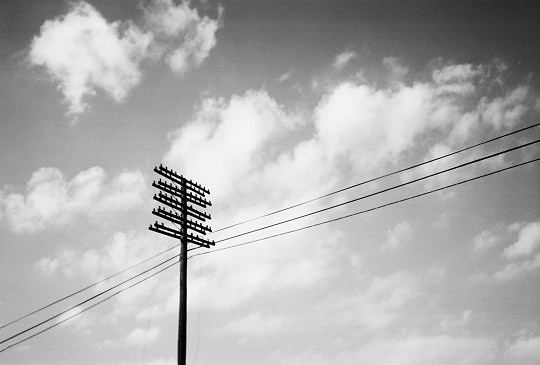
I spotted the insulator of the day just west of Oliver Street. Atop a pole
near the junkyard was a crossarm with eleven insulators, including four on a
tramp bracket. Ten were aqua #42s. The eleventh was a very dark CD 152 She was
such a dark green that she was almost purple. I repeatedly walked back and forth around the pole, staring up
at that insulator. Even against a cloudless sky with January sunshine, the
insulator passed almost no light.
Chase for Case
March 24, 1995 was a busy Friday in Houston. I was involved
with a project for my legal research and writing course, and I had given
presentations for courses in property law and torts that day. When I got out of
the tort class, a blustery March wind was blowing through downtown Houston, and
insulators were on my mind. After stopping by my apartment to change clothes,
off to Washington Avenue I went.
About eight or ten poles, including a terminal pole, stood between the Amtrak
station and the Houston Avenue underpass. Approximately halfway in between was a
vine-covered pole with a broken middle crossarm. The pieces of the crossarm,
which was the second lowest out of five crossarms, hung limply in the scraggly
vines. The higher half had three CD 154s on it. The lower half had a Rogers Case
bracket bolted to it. I had a couple of loose CD 1049s in my collection, but
here was an opportunity to get a complete rack of them.
I drove my Sunbird over to Houston Avenue and parked it on a nearby side
street. Carrying a plastic bag from an auto parts store and a set of channel
locks I had purchased from the downtown Woolworth's, I crossed Houston Avenue
and walked up a dead-end alley between a police officer uniform store and a day
care facility for a nearby Lutheran Church. The pavement of this alley stopped
at the railroad embankment, beside a metal storage building.
I climbed up the embankment. On the other side of the tracks was a city
vehicle graveyard. The wrecked, totaled, and parted-out remains of more than a
hundred Ford Crown Victorias, Chevrolet Caprices, and Dodge Diplomats littered a
huge concrete lot. Beside a garage building sat the gargantuan remnants of a
butchered Houston fire truck. To keep a low profile, I walked in the trackside
ditch. I kept my ears peeled for locomotives, but no train came.
The pole stood behind a unused multistory building. As I stood beside the
pole, I could reach the tip of the crossarm half with the Case bracket. Somehow,
a copper wire was still attached between one of the CD 1049s and the crossarms
above. I pulled the half towards me and untied the wire with the channel locks.
I then crouched down and unbolted the Case bracket from the crossarm half,
saving everything but the wood.
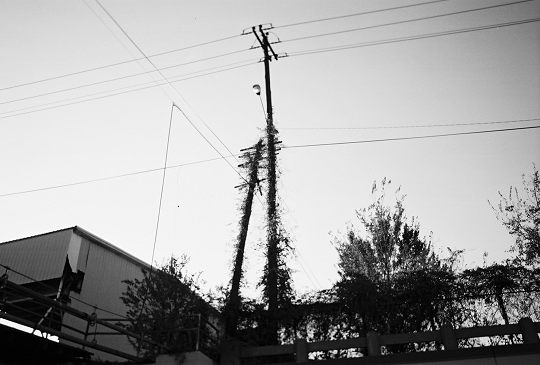
I packed the Case bracket along with its bolts and the channel locks into the
auto parts store bag. I then calmly walked back to my car and went home with my
new find. I cleaned it up as best I could. The CD 1049 inserts had quite a bit
of chipping on them, but I was still glad to have a Case bracket, complete with hardware, in my
collection. I later found two more near the Houston Ship Channel's Turning
Basin. All three are still in my collection today.
At the Junction
Just east of Studemont Street is Chaney Junction, where the
north track that serves the Mahatma Rice elevator and the train yard just north
of downtown merges into the main line. Between the junction switch and the
Studemont Street underpass stands one of the Southern Pacific poles. On a number
of occasions, I had driven through the underpass to look up at the five doubled
crossarms on this pole.
On an afternoon in April 1996, I was driving by the pole when I noticed that
the two uppermost sets of the five doubled crossarms had been removed from it.
At the very top of the pole was a metal gadget that resembled an old-fashioned
outdoor television antenna. Needless to say, the following Saturday was a day to
walk the tracks. I started again by the hardware store and headed west, humming
the Doobie Brothers' "Long Train Runnin'" under my breath. Along the
way, I looked at the arms of the poles to see if there was anything I hadn't
noticed before. Near the Silver Street crossing, I discovered two clear CD 115s
on the lowest arm of one pole, a bizarre sight on a railroad line.
I reached the Chaney Junction pole and was greeted with total destruction.
The four arms lay in the trackside ditch like a strange sculpture. As many as
twenty aqua CD 214 Hemingrays lay in the grass around the pole, and most were
smashed. An old gumball machine with a shattered glass globe also lay in the
middle of this mess. I did some scrounging and found five that were chipped but relatively whole.
Finally, I took a look at the crossarms in the ditch. At the end of one crossarm
was a CD 214 that somehow escaped the mayhem. Except for one skirt peck, she was
mint.
Finding six insulators in downtown Houston was one thing, but getting them
home was another. It just so happened that there was a bodega with a couple of
Texaco self-service pumps just south of the junkyard, and I was fortunate enough
to have brought a couple of dollars with me. I casually walked down. to the
bodega, went inside, and bought a Coke. The cashier thought it was strange that
someone would request a bag for a soft drink purchase. Nevertheless, he provided
one when I asked for it.
Afterwards, I quietly walked back to the pole. I removed the Coke from the
bag and set it aside. I then very carefully set the six insulators into the
plastic bag. One of the CD 214s still had a copper wire tied in her saddle
groove, but I managed to make things fit. With no packing material handy, the
trip home would have to be very gentle. The insulators were not to be jarred, so
I opted not to walk on the tracks.
Instead, I detoured down a railroad spur that serves the Sacks Waste Paper
recycling plant on Studemont Street. I passed the bakery truck yard and
Detering's brickyard to Washington Avenue, sipping the Coke and taking the
sidewalk all the way back to my high-rise apartment with the insulators in tow.
A group of young people near downtown's Jones Hall gave me some curious stares,
but I shrugged them off.
To be continued next month.......
| 